Method and apparatus for model-driven business performance management
a business performance management and model-driven technology, applied in the field of model-driven business performance management, can solve the problems of large number, time-consuming platform-dependent implementation, and complex data structure of metric data, and achieve the effect of improving evaluation performance and optimizing computation performan
- Summary
- Abstract
- Description
- Claims
- Application Information
AI Technical Summary
Benefits of technology
Problems solved by technology
Method used
Image
Examples
Embodiment Construction
[0025] Referring now to the drawings, and more particularly to FIG. 1, there is shown an example of observation model to illustrate the design of observation meta-model. The requirements of an BPM solution are captured by an observation model. The specification of observation models is given by the observation meta-model. The meta-model is a simplified version of that which is described by Joachim H. Frank and Ghaly Gamil Stefanos in “Business Operations Metamodel”, Technical Report, International Business Machines Corp., January 2005. The meta-model describes two aspects of an observation model.
[0026] The information in an observation model is typically constructed top-down. Formally, an observation model (see Unified Modeling Language (UML) model in FIG. 2) contains a hierarchy of contexts. For example, in FIG. 1, the root context contains two contexts store and warehouse, and context store further contains context customer. A context corresponds to an entity to be monitored. The...
PUM
 Login to View More
Login to View More Abstract
Description
Claims
Application Information
 Login to View More
Login to View More - R&D
- Intellectual Property
- Life Sciences
- Materials
- Tech Scout
- Unparalleled Data Quality
- Higher Quality Content
- 60% Fewer Hallucinations
Browse by: Latest US Patents, China's latest patents, Technical Efficacy Thesaurus, Application Domain, Technology Topic, Popular Technical Reports.
© 2025 PatSnap. All rights reserved.Legal|Privacy policy|Modern Slavery Act Transparency Statement|Sitemap|About US| Contact US: help@patsnap.com



